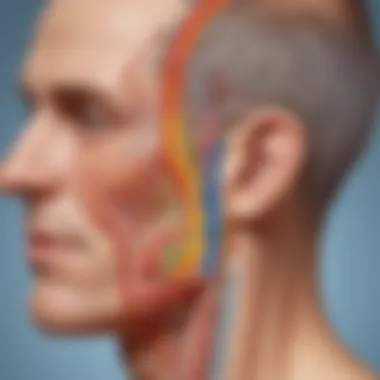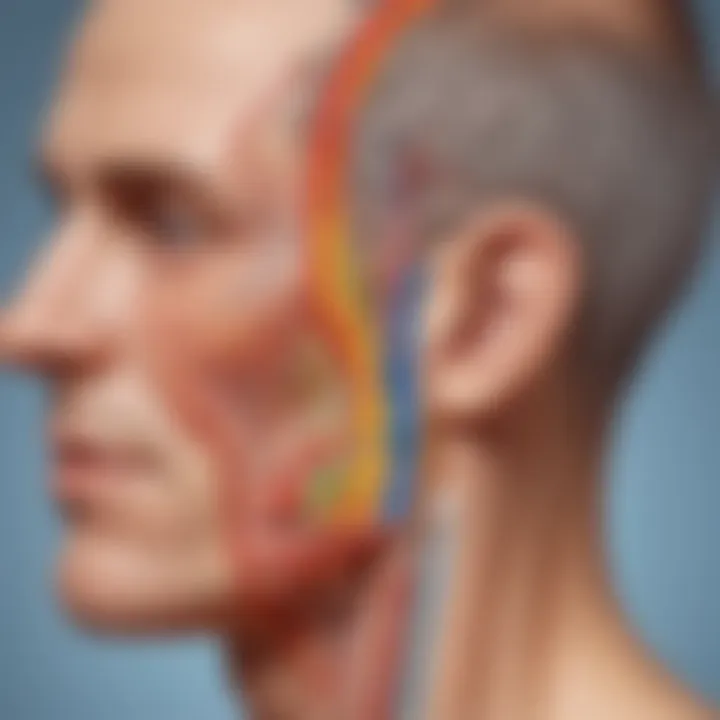Exploring the Optimal Temperature Range for Humans


Intro
Temperature regulation in the human body is not just about feeling hot or cold; it is a fine balance that affects our health and comfort. Understanding how we respond to different temperatures can help us make informed decisions about our well-being. This exploration will uncover the physiological mechanisms behind temperature regulation, the effects of extreme temperatures, and how our environment shapes our experience of temperature.
Science Fun Facts
When diving into the world of temperature and the human body, there are a few fun facts that may surprise you:
- Did you know that the average human body temperature is around 98.6°F (37°C)? However, this can vary from person to person and throughout the day.
- The body can lose heat in several ways: conduction, convection, radiation, and evaporation. If we sweat, our body cools down through evaporation.
- Hottest recorded temperature on Earth was a scorching 134°F (56.7°C) in Furnace Creek Ranch, Death Valley in 1913. Imagine experiencing that!
- Freezing point for humans is not set in stone. Some individuals, especially in extreme sports, have survived temperatures below
- Dogs and Cats have a higher body temperature than humans, usually between 100.5°F to 102.5°F. So, next time your furry friend seems warm, that might be normal for them.
Interesting Trivia and Facts
- The coldest temperature recorded in Antarctica was -128.6°F (-89.2°C) at Vostok Station in 1983. This is colder than a typical freezer!
- Humans have evolved to survive in various climates, adapting to heat in regions like the Sahara and the cold in Siberia.
Quirky Science Stories
One fascinating story comes from the trials of extreme athletes. In the 1996 Atlanta Olympics, competitors faced a heatwave, leading to many athletes pushing their limits. A marathon runner had to push through temperatures reaching 90°F (32°C), showcasing the body’s ability to adapt but also highlighting the risks involved. Hydration was key; without it, the body would struggle with thermoregulation.
Amazing Science Records
The human body is exceptional at handling extremes, but it isn’t foolproof. The world record for the longest time spent in freezing water is held by Wim Hof, who wowed scientists with his ability to withstand subzero temperatures. His training methods have opened doors in understanding how humans can endure harsh climates.
"The human body is capable of remarkable adaptations. With the right methods, some can endure what many would find unbearable."
Thought-Provoking Questions
- How do our bodies know when to shiver or sweat? Understanding this mechanism can help improve our health habits.
- What might happen if we lived in constant temperature extremes? Consider the long-term effects on our health and well-being.
Discover the Wonders of Science
Understanding temperature is not just about science; it connects to real-life situations. Have you ever thought about why we feel cooler near water?
Exploring Various Scientific Concepts
- Thermoregulation: the physiological process that allows humans to maintain an internal temperature around 98.6°F. This involves sweating, blood flow adjustments, and even behavior changes like wearing sweaters.
- Heat Stress: When the environment is hotter than our body, it can lead to health problems like heat exhaustion, which is crucial to recognize during hot months.
Educational Videos and Animations
Several educational platforms have engaging videos about thermoregulation, explaining concepts such as heat exchange and body adaptation.
Interactive Learning Tools
Interactive websites allow you to see how different fabrics insulate heat or cool you down. Explore these tools to gain practical insights into temperature control!
Real-Life Applications of Science
Understanding the body’s reaction to temperature influences:
- Clothing choices
- Recommendations for activities in varying temperatures
- Insights into seasonal health care
Science Quiz Time
To engage our minds further, let’s try a quiz to see how much we’ve learned!
Interactive Quizzes
- What is the average human body temperature?
a) 95°F
b) 98.6°F
c) 100°F
d) 102°F - Which process cools the body through sweat?
a) Conduction
b) Convection
c) Radiation
d) Evaporation - Extreme cold can lead to which of the following?
a) Hypothermia
b) Heatstroke
c) Frostbite
d) Both a and c
Brain Teasers and Puzzles
Think about this: if your body temperature drops even a few degrees, how does it affect your performance in everyday tasks? Reflect on how temperature affects your focus or energy levels.
Learning Through Gamification
Many online games incorporate elements of temperature regulation, making them fun ways to learn about our body’s responses.
By the end of this exploration, we hope to foster a better understanding of how temperature impacts our lives, health, and overall well-being.
Prelims to Human Temperature Range
Understanding the intricacies of the human temperature range is vital for various reasons. This section not only serves as a gateway to the vast realm of thermal comfort but also lays the groundwork for grasping how temperature regulation intricately supports our well-being.
Defining Temperature Range
Temperature range refers to the spectrum within which the human body operates optimally. Typically, this spans from about 36.1°C to 37.2°C (97°F to 99°F) in healthy adults. However, it’s crucial to understand that this range can fluctuate based on factors like time of day, level of physical activity, and overall health.
For instance, during vigorous exercise, the body temperature can soar, occasionally reaching beyond 38°C. Similarly, it is common for core body temperature to dip slightly during sleep, due to a decrease in metabolic activity. These fluctuations illustrate that while a specific range exists, individual variations might tilt the scale slightly.
Importance of Temperature in Human Physiology
Temperature is more than just a measurement; it is a cornerstone of human physiology. Maintaining a stable internal environment is critical for enzymatic reactions, hormone activity, and the overall metabolic process. When your body temperature veers too far outside of the ideal range, various systems can go haywire, resulting in conditions that could threaten your health.
One vivid example is the role temperature plays in immune response. When you have a fever, your body is intentionally elevating its temperature in a bid to fight off infections. This reaction underscores the dynamic relationship between our temperature and overall health—too cold and bodily functions can slow down, too hot and you risk heat stress-related illnesses.
"Temperature regulation is not merely about comfort; it's fundamentally tied to how your body functions on a cellular level."
Understanding this relationship is crucial for health practitioners, athletes, and even everyday individuals aiming to optimize their well-being. This foundation sets the stage for a deeper exploration of how our bodies respond to various stimuli and environmental conditions.
Physiological Mechanisms of Temperature Regulation
Understanding how our body maintains a stable temperature is crucial for grasping the broader implications of human health. This section will delve into the physiological mechanisms that support temperature regulation, which plays a pivotal role in homeostasis—our body's balance that keeps us alive and functioning properly. The human body needs to operate within a specific temperature range to optimize cellular activities, and any deviation from this norm can lead to significant health issues.


Homeostasis and Thermal Balance
Definition of Homeostasis
Homeostasis can be simply described as the body’s effort to maintain a stable internal environment despite external changes. This is particularly relevant in temperature management, where small shifts can have substantial effects on overall health. A key characteristic of homeostasis is its dynamic nature; it involves constant adjustments based on various stimuli that our body encounters. This adaptability is essential as it enables responses to environmental changes, ensuring that vital processes continue uninterrupted.
One unique feature of homeostasis is its feedback loops, mostly negative feedback. When body temperature rises or falls, receptors send signals to the brain, prompting necessary adjustments—like sweating to cool down or shivering to raise body temperature. Such mechanisms are beneficial as they quickly counteract potential disruptions. However, the limits of homeostasis can be tested in extreme conditions, which may hinder its efficacy.
Role of the Hypothalamus
The hypothalamus serves as the body's thermostat, regulating temperature through various pathways. It plays an indispensable role in maintaining thermal equilibrium by initiating responses to thermal alterations. A defining characteristic of the hypothalamus is its intricate network of neurons that detect temperature changes and relay the information throughout the body. This central location makes it a focal point for temperature regulation and response.
A unique aspect of the hypothalamus is its ability to integrate information from the entire body, adjusting its outputs accordingly. This makes it a crucial player not just in temperature regulation but in many other homeostatic processes. While it's advantageous to have a central command, complications can arise if the hypothalamus is damaged or impaired, leading to conditions like hyperthermia or hypothermia without the body's normal regulatory responses.
Response to Heat
Sweating Mechanisms
When temperatures soar, our body employs sweating as a primary mechanism to cool down. Sweating works by producing moisture, which evaporates and draws heat away from the body. One of the notable aspects of sweating is its efficiency; a liter of sweat can cool the body significantly. This process is not just beneficial; it’s vital for survival in hot environments.
A unique feature of sweat glands is their ability to be activated by both heat and stress. Essentially, they can work double duty, cooling the body while providing signals to help manage stress. The downside can be dehydration if sweating is excessive without proper rehydration. Thus, adequate fluid intake becomes critical in maintaining this mechanism's effectiveness.
Vascular Adjustments
As the body heats up, another regulatory mechanism comes into play—vascular adjustments. Our body optimizes heat loss through blood circulation. When temperatures rise, blood vessels in the skin dilate, allowing more blood to flow near the surface, which enhances heat dissipation. This process is a classic example of our body’s adaptability.
The critical trait of this mechanism is its quick response; it can adjust in seconds, balancing the body’s cooling needs. This brings a unique advantage for those living in warmer climates, allowing for better acclimatization over time. However, challenges arise in extremely hot conditions, where the body's capacity to adjust may be overwhelmed, leading to potential heat-related illnesses.
Response to Cold
Shivering Mechanisms
When the temperature drops, our body employs various responses, and one of the most notable is shivering. Shivering is the involuntary contraction of muscles, which generates heat through increased metabolic activity. A defining characteristic of this process is its energy consumption; shivering can ramp up metabolism significantly, warming the body up quite effectively.
One unique feature of shivering mechanisms is their ability to kick in quickly, even if the temperature drops suddenly. Yet, this approach has its drawbacks—prolonged shivering can lead to fatigue and energy depletion, particularly in sub-zero temperatures where external factors pose higher risks.
Thermal Insulation
Thermal insulation represents another line of defense against cold. This is where fat and clothing intervene. The body naturally has layers of fat under the skin that serve as insulation, limiting heat loss. An essential characteristic of insulation is that it provides a barrier to heat escape, allowing the body to maintain its core temperature more effectively.
Clothing can enhance this natural insulation significantly. The unique feature of layering, for example, can trap air between layers, creating an additional barrier against the cold. However, one must be cautious of overheating in warmer conditions when wearing too many layers, which can reverse the benefits of insulation.
"The human body has adapted remarkably to varying climates, though extreme temperatures still present challenges that must be managed effectively."
Normal Body Temperature Range
Understanding the concept of normal body temperature is vital for grasping how the human body functions under varying conditions. Normal body temperature is not a static figure; it can fluctuate based on numerous factors including time of day, physical activity, and even the age of a person. Moreover, this range serves as a benchmark for evaluating health. When the body temperature strays into abnormal territories, it often signals underlying health issues or environmental stressors.
Average Temperature Values
Typically, the average body temperature for a healthy adult hovers around 98.6°F (37°C). Yet, this is more of an averaged nuance rather than a hard and fast rule. Recent studies suggest normal body temperature can range from 97°F (36.1°C) to 100.4°F (38°C). This variation reflects how unique individual metabolisms and external conditions can be.
It's worth noting that temperature varies throughout the day too. The early hours may show a cooler reading, while afternoon and evening can warm up due to increased activity. Conditions like the flu or intense exercise can also nudge the thermometer upwards. Thus, getting a grasp on personal baselines can be tremendously useful.
Variability Among Individuals
In our quest to comprehend normal body temperature, we must acknowledge that it isn't one-size-fits-all. Variability among individuals can point to age-related shifts and differences based on gender.
Age-Related Differences
Age plays a significant role in determining what constitutes a normal temperature. For instance, newborns tend to have a slightly higher body temperature than older children and adults, with the normal range around 97.9°F (36.6°C) to 100.4°F (38°C). As we age, our body’s capability to regulate temperature may decline. This can make older adults more susceptible to temperature fluctuations, often resulting in a lower baseline. Understanding these changes allows for more accurate assessments of health, especially when interpreting fever signs in elderly patients.
Gender Differences
When it comes to gender, studies reveal that women generally register higher temperatures than men, possibly due to hormonal fluctuations, particularly during their menstrual cycles. The difference might seem small but can influence how we interpret temperature ranges. For instance, the normal range for women can climb slightly above the average noted for men during certain times of the month. This highlights the importance of recognizing gender influences on body temperature, helping to fine-tune health assessments.
"Individual experiences of body temperature require a nuanced approach to keep track of health and wellness."
In summary, understanding body temperature requires proficiency in recognizing both averages and individual deviations. Knowing the average temperature values alongside the variability among individuals fosters a more complete picture of human health, fortifying our grasp of thermal comfort and physiological responses.
External Temperature Influences
Understanding external temperature influences is imperative to fully grasp human comfort and health regarding temperature. The way we experience temperature isn't isolated; it is intricately linked to various external elements. These factors shape our body’s response and, subsequently, our overall well-being. Recognizing these influences allows us to manage our environments for better thermal comfort.
Environmental Factors
Humidity Levels
Humidity is a critical factor that plays a key role in how temperature is perceived. Simply put, it's the amount of moisture in the air. When humidity levels rise, the air can feel much warmer than the actual temperature. This is due to the body's inability to cool itself through perspiration as easily. When humidity is high, sweat doesn’t evaporate as it should, leading to a feeling of sluggishness. High humidity can actually stress our bodies, raising the risk of heat-related ailments.
A unique characteristic of humidity is that it varies significantly in different geographic locations. For example, tropical climates can have high humidity all year round, which makes the heat feel even more oppressive. On the flip side, arid regions typically experience lower humidity. The challenge is that while high humidity provides a feeling of warmth, it also increases the discomfort index, making it important to stay hydrated and seek shade.
Wind Speed
Wind speed can dramatically alter how we perceive temperature. When the wind blows, it can whisk away the thin layer of warm air surrounding our bodies, leading to what’s known as the "wind chill effect." This can make even mild temperatures feel considerably colder, especially in colder months. Imagine a day that feels pleasant at 50°F without wind, but you step outside in a breeze and it feels like 40°F. This powerful impact illustrates why wind speed is important in understanding thermal comfort.
Fast-moving air can also make heat less bearable during hot months. Therefore, windy conditions often cool us down effectively when we’re hot, but can turn chilly when temperatures dip. It’s a double-edged sword—one minute you’re enjoying the breeze, and the next, you’re feeling cold. This variability makes it essential to consider wind speed when planning outdoor activities, whether for work or leisure.
Seasonal Variations
Summer Heat Challenges


Summer often brings about significant challenges regarding heat management. With longer daylight hours and higher temperatures, the body can struggle to maintain a comfortable temperature. As the heat intensifies, it can lead to various heat-related issues, from simple discomfort to serious health problems like heat exhaustion or heat stroke.
One of the hallmarks of summer heat is that it can lead people to become more sedentary, avoiding the outdoors during peak hours due to the oppressive heat. However, access to shade and hydration remains crucial. On the plus side, seasonal variations allow us the chance to enjoy activities like swimming or other water-based fun that can help cool down our bodies.
Winter Cold Exposure
Similarly, winter cold poses its own set of challenges. As temperatures drop, the risk of hypothermia and frostbite increases. Being in cold conditions can numb parts of the body, which makes it difficult to recognize when there’s a real threat.
In colder months, taking precautions is a must. Dressing in layers is more than just a fashion statement; it is a crucial strategy for maintaining a healthy body temperature. The unique feature of winter cold exposure is that while it often encourages cozy indoor activities, it also necessitates careful planning when venturing outdoors.
Being aware of seasonal variations in temperature is crucial for making informed decisions about activities and how to dress appropriately. Each season presents its own set of benefits and risks, stressing the importance of understanding how to adapt to these changes effectively.
Extreme Temperature and Its Effects
Understanding extreme temperatures is crucial in our exploration of human temperature ranges. Extreme heat or cold can significantly affect health and overall wellbeing. The body has mechanisms to cope with variations in temperature, yet these systems can be overwhelmed during extreme conditions. This can lead to serious health concerns that vary from heat exhaustion during hot spells to hypothermia in freezing environments. Recognizing these impacts is vital for preventing health risks and ensuring safety in diverse settings.
Heat Stress and Heat-Related Illnesses
Heat stress occurs when the body cannot cool itself adequately, resulting in various illnesses related to excess heat. Recognizing the symptoms and risks associated with heat conditions is critical for individuals who might find themselves in warm climates or during heat waves.
Symptoms of Heat Exhaustion
Heat exhaustion manifests as a collection of symptoms such as weakness, excessive sweating, headaches, and nausea. A defining characteristic of heat exhaustion is its gradual onset; it creeps up on an individual rather than hitting them out of the blue. This subtlety makes it an important point of focus. Recognizing these symptoms early is pivotal, as they serve as a warning sign to seek shade, hydrate, or cool down before more severe conditions like heat stroke set in.
What sets these symptoms apart is how they connect back to the body’s efforts to maintain a safe internal temperature. These signs also highlight the significant role hydration and environmental awareness play in health management. As hydration decreases and temperatures rise, it can become a losing battle against the elements. Therefore, understanding heat exhaustion is beneficial in the context of preventing its escalation.
Risk Factors for Heat Stroke
Heat stroke is a more severe illness resulting from prolonged exposure to high temperatures, often due to exertion in the heat. Risk factors include factors like age (the very young or old are particularly vulnerable), high humidity, and certain health conditions. A key characteristic of heat stroke is its rapid onset, often coupled with a temperature rise above 104°F (40°C). This makes it a pressing concern for those participating in outdoor activities during hot days.
What distinguishes this condition is its life-threatening potential. Heat stroke can lead to organ failure and even death, highlighting the need for awareness of situations or activities that may increase risk. Individuals should consider relevant precautions such as taking breaks in shaded areas and maintaining fluid intake. Knowing and understanding these causes and effects is essential for anyone engaged in outdoor activities during summer months.
Cold Stress and Hypothermia
Cold stress presents a stark contrast to heat stress, where the body struggles to maintain its core temperature in excessively cold conditions. Hypothermia can set in when the body's heat loss surpasses its production, leading potentially to life-threatening situations. Understanding this balance is essential for people in colder climates or those preparing for outdoor winter activities.
Signs of Hypothermia
Signs of hypothermia can include shivering, confusion, slow speech, and exhaustion. A notable feature of hypothermia is that it can develop gradually, sneaking up on individuals, especially during prolonged exposure to cold and wet conditions. Recognizing these signs early allows individuals to seek shelter and warm-up mechanisms before it becomes critical. The distinct aspect of hypothermia is how it can affect mental faculties, leading to poor decision-making, thereby complicating a person’s ability to protect themselves.
It is beneficial to point out how contrasting symptoms, like shivering, might have previously been viewed as merely uncomfortable but signal immediate concern for safety when the cold is extreme.
Preventive Measures in Cold Weather
Preventive measures against cold stress include wearing appropriate clothing, staying dry, and recognizing the onset of cold stress symptoms. A characteristic feature of effective prevention is layering, which traps air and provides insulation. This choice stands out in discussions of cold exposure, as it combines practicality and effectiveness in keeping the body warm.
One unique aspect is how cultural norms around clothing can vary widely; while some might opt for heavy coats, others might use thermal base layers. Regardless of technique, the goal remains the same: maintaining body warmth to prevent hypothermia. The advantages of such measures greatly outweigh the challenges, making them a vital part of safely navigating cold weather.
Adaptation to Temperature Extremes
Adaptation to temperature extremes plays a crucial role in human survival and comfort. As temperatures swing between the boiling heat of summer and the biting cold of winter, how we respond and adapt can significantly affect our health and efficiency. Understanding these adaptations can help individuals cope better with their environments, fostering not only personal resilience but also paving the way for cultural advancements in response to climate realities.
Short-Term Adaptations
Acclimatization to Heat
Acclimatization to heat refers to the process through which the body gradually adjusts to high temperatures. This adaptation is particularly significant for individuals moving to warmer regions or during hot seasons. The key characteristic of this acclimatization is the body’s enhanced ability to sweat efficiently, improving thermoregulation.
- Benefits: This adjustment helps in preventing heat-related illnesses like heat exhaustion. It decreases heart rate during exercise in high temperatures, allowing for better performance.
- Unique Feature: One unique aspect of acclimatization to heat is the increased plasma volume in the blood. More plasma means better circulation and aids in cooling the body effectively. However, it takes time—often several days—to fully acclimate.
- Disadvantages: If an individual rushes this process or fails to optimally hydrate, it may lead to dehydration or heat cramps.
Acclimatization to Cold
On the flip side, acclimatization to cold involves the body adapting to lower temperatures. This process is vital for those who live in colder climates or engage in winter sports. The most notable feature of cold acclimatization is the enhancement of shivering and the adjustment of blood flow to maintain core temperature.
- Benefits: This adaptation enables the body to conserve heat better, which can be crucial for avoiding hypothermia. As such, it enhances physical endurance in cold weather.
- Unique Feature: An important element in this acclimatization is the way blood vessels constrict to preserve warmth. However, the effectiveness can vary among individuals.
- Disadvantages: If someone remains exposed to extreme cold without proper gear, the risk of frostbite increases, which can lead to serious health issues.
Long-Term Adaptations
Physiological Changes
Long-term adaptations often manifest in significant physiological changes. These adjustments take place over extended periods and can reshape how an individual’s body functions under persistent temperature pressures. A key characteristic of these changes is genetic adaptation, often seen in populations accustomed to extreme climates.
- Benefits: For example, people living at high altitudes or in colder regions might develop larger lung capacities or thicker skin, respectively. This trait can be beneficial in enhancing overall health and physical performance.
- Unique Feature: A unique feature here is the evolutionary aspect. Populations that have dealt with extreme conditions for generations might display traits not found in the general population. However, these adaptations take significant time and are not reversible in the short term.
- Disadvantages: Not everyone has the same capacity to adapt, potentially leading to health disparities among populations.
Cultural Adjustments
Cultural adjustments reflect the societal changes that accompany temperature extremes. This aspect highlights how communities develop practices, clothing, and lifestyles suited to their climates. A key characteristic here is the innovation in clothing and construction methods.
- Benefits: Cultural adaptations, such as using breathable fabrics in hot environments or insulating homes in cold climates, can greatly improve daily living conditions.
- Unique Feature: The fascinating point here is the blend of technology and tradition. Different cultures have developed unique solutions based on their experiences over years. Yet, rapid urbanization may erode these traditional methods.
- Disadvantages: Relying solely on modern technology without considering local practices could lead to inefficiencies or environmental drawbacks.
Adapting to temperature extremes isn't merely a biological process; it is a holistic approach that involves understanding physical, cultural, and technological realms.
Understanding these complexities prepares individuals to engage with their environment more effectively, ensuring better health outcomes and enhancing the human experience in the face of climate variability.
The Role of Clothing in Temperature Regulation
Clothing plays a critical part in how our body manages temperature. It acts as a barrier between us and the environment, influencing how much heat we lose or retain. The right clothing can help us maintain our body’s ideal thermal balance, which is vital for overall comfort and health. Understanding the role clothing plays can help us make informed decisions about what to wear in different conditions and how to adapt to various climates.
Insulating vs. Breathable Fabrics
When it comes to clothing materials, there's a significant difference between insulating and breathable fabrics.
Insulating fabrics provide warmth by trapping air that our body heat warms up. Think about wool or fleece. These materials keep us cozy during chilly seasons, enabling us to retain more heat. An example would be a thick wool sweater, which helps keep body heat close on a cold winter day.


On the other hand, breathable fabrics like cotton, or specially designed synthetic materials, allow moisture and heat to escape from our body. This is crucial during warm weather or when engaging in physical activities, as it helps prevent overheating and keeps us feeling fresh. For instance, a lightweight cotton t-shirt is great for those summer outings.
Choosing the right fabric can depend heavily on the activity and the temperature outside. In the cold, layering with insulating pieces helps, while in heat, opting for breathable materials is key.
"The right choice of clothing can make the difference between feeling uncomfortable and being able to enjoy the day outside."
Layering Techniques
Layering is another essential strategy in temperature regulation. This technique isn’t just about putting on multiple layers for the sake of it; it’s about managing warmth without overheating.
When layering, consider these key principles:
- Base Layer: This layer sits closest to the skin. Its job is to wick away moisture. Look for materials like merino wool or specialized polyester.
- Middle Layer: This layer is about insulation. Fleece or down jackets work well here, as they trap body heat effectively.
- Outer Layer: The outermost layer shields us from wind and rain. A durable, waterproof jacket, preferred in many colder climates, can do wonders to keep the warmth in and the elements out.
Layering also allows flexibility. As the day progresses, or as activities change, you can easily add or remove layers, adjusting to your comfort level without a complete wardrobe change.
In sum, when thinking about maintaining a comfortable temperature, both the type of fabric and how we layer our clothing are fundamental. They are essential tools in our daily toolkit for managing the heat flow between our bodies and the environment.
Technological Advances in Temperature Management
Technological progress has brought about remarkable changes in how we manage human temperature regulation. The importance of this topic lies in its profound implications for health, comfort, and performance. The increasing prevalence of temperature fluctuations and extreme weather conditions emphasizes the necessity for innovative solutions to maintain our thermal balance.
Wearable Technology
Temperature Monitoring Devices
Temperature monitoring devices have emerged as critical tools in tracking body heat. These devices directly contribute to understanding an individual's thermal state and detecting potential issues, such as overheating or hypothermia. Their key characteristic is the ability to provide real-time data, which allows users to make informed decisions about their activities and attire. These tools are popular for their practical application in both everyday scenarios and specialized settings, like sports or healthcare.
A standout feature is their integration with mobile applications, enabling users to receive alerts when their body temperature deviates from the norm. This immediate feedback can be beneficial, as it helps in taking preventative measures against heat-related illness or ensuring comfort in various conditions. However, depending on battery life and accuracy, some devices could have limitations, which is important to consider when choosing the right monitoring system.
Smart Fabrics
Smart fabrics represent another intriguing aspect of wearable technology, boasting functionalities that adapt to environmental changes. These fabrics contribute significantly to temperature management by regulating heat and moisture, enhancing comfort for the wearer. A noteworthy characteristic is their ability to absorb sweat and release heat, making them particularly desirable for physical activities where temperature control is crucial.
The unique feature of smart fabrics is their incorporation of micro-sensors that adjust based on the wearer’s body temperature. While these fabrics offer impressive advantages, including improved comfort and potential health benefits, they may come with a higher price tag and complexity in maintenance compared to traditional fabrics. As such, selecting suitable smart clothing entails weighing functionality against cost.
Climate Control Systems
Heating Systems
Heating systems form a foundation for maintaining a warm environment, especially during colder months. Their main contribution aligns with supporting human health and comfort, particularly in regions prone to severe weather. A key characteristic is their ability to distribute heat evenly across spaces, fostering a more pleasant atmosphere. This capability makes heating systems an indispensable choice in modern households.
An interesting facet is the development of smart heating systems that can be programmed or controlled remotely via mobile devices. These innovations promote energy efficiency while ensuring that users' thermal comfort needs are met. However, reliance on technology and potential for system failures are considerations to bear in mind when implementing such solutions.
Cooling Systems
On the other hand, cooling systems are vital in combating the heat, especially in warm climates. Their primary role centers on regulating indoor temperatures to provide relief from external heat. The key characteristic of cooling systems lies in their ability to create a significant temperature drop in a short span. This quality makes them particularly favored during intense heatwaves.
Like heating solutions, modern cooling systems often include smart features that allow for personalized temperature settings. They can adapt based on occupancy and time of day. However, it should be noted that depending on the type of cooling system, there might be issues related to energy consumption and costs associated with prolonged use.
Understanding how these technologies work and their potential is crucial for optimizing both health and comfort in changing climates.
Implications for Health and Performance
The connection between temperature and our health cannot be overstated. Understanding the implications of human temperature range is essential, as it impacts several aspects of our daily lives. From maintaining optimal physical performance to ensuring overall well-being, temperature directly influences how our bodies function.
Factors like humidity, clothing choices, and even our activities affect our thermal perception. Knowledge of these implications can empower individuals to make informed decisions related to their health and activities. For parents and caregivers, this awareness can guide how they protect young ones or vulnerable individuals from temperature extremes.
Understanding your body’s response to temperature is more than mere science; it’s about enhancing life quality and promoting well-being.
Effects on Physical Performance
Physical performance, whether in sports or daily activities, is heavily influenced by the ambient temperature. When the surroundings are too warm, our bodies struggle to dissipate heat, leading to fatigue and decreased coordination. Likewise, extremely cold environments challenge our body’s ability to perform optimally, often resulting in stiffness and reduced agility.
- Thermal Stress: High temperatures can lead to heat exhaustion or even heat stroke, impairing not only performance but also overall health.
- Optimal Range: The ideal temperature for peak performance generally ranges from 55°F to 75°F (13°C to 24°C). Outside this window, the body struggles to maintain harmony, affecting recovery and resilience.
Parents guiding children in sports or outdoor activities should be particularly watchful. It’s critical to acclimatize young athletes to their training conditions, ensuring they learn to recognize signs of thermal stress in themselves and their teammates.
Understanding Thermal Comfort
Thermal comfort refers to the state in which one feels neither too hot nor too cold. It’s a complex concept, influenced by not only the temperature but also other factors like humidity and wind speed. Recognizing these elements is vital for both health and productivity.
Recognizing what contributes to feeling cool or warm can help tailor environments to improve comfort. For instance:
- Humidity Matters: High humidity can make warm days feel much hotter, affecting mood and concentration.
- Wind Chill: Conversely, even a modest temperature can feel colder if there’s significant wind. Wind chill can sap warmth from the body, making proper attire essential.
With an understanding of these factors, parents and caregivers can better equip children for outdoor activities regardless of the conditions. This proactive approach supports their health while fostering an appreciation for the world around them.
Ending
The exploration of human temperature ranges is not merely an academic exercise; it possesses vital implications for our everyday lives. Understanding how temperature affects us plays a crucial role in maintaining our health, safety, and overall well-being.
Summary of Key Points
Throughout this article, various aspects of the human temperature range were covered:
- Normal Body Temperature: The average body temperature is generally accepted to be around 98.6°F (37°C). However, individual variations exist based on age, gender, and time of day.
- Physiological Mechanisms: The body has sophisticated methods of maintaining homeostasis, enabling us to adapt to fluctuating temperatures. The hypothalamus is a key player in monitoring and regulating these changes.
- Effects of Extreme Temperatures: Excessive heat can lead to heat exhaustion or heat stroke, while extreme cold can bring about hypothermia. Recognizing the signs of these conditions is important for prevention.
- Clothing and Technology's Role: Wearing appropriate clothing can significantly impact thermal comfort. Advances in technology, such as smart fabrics and wearable devices, also provide valuable tools for managing temperature.
- Health and Performance Implications: Temperature significantly influences physical performance. Understanding how to maintain thermal comfort is essential for athletes and daily life activities.
The interplay between environment, physiology, and technology shapes our ability to thrive in varying temperatures. Balancing these factors wisely can lead to improved health outcomes and enhanced comfort.
Future Directions in Temperature Research
As the world faces climate change and unprecedented weather variations, future research is likely to delve deeper into several important fields:
- Innovations in Fabric Technology: Continued exploration of materials that regulate temperature more effectively could help create better clothing options for various climates.
- Impact of Climate Change: Understanding how shifting weather patterns affect individual temperature regulation and public health outcomes is crucial. Research in this area could inform community planning and emergency response strategies.
- Physiological Studies: Further studies on how different populations adapt psychologically and physically to temperature extremes could reveal more about the human capacity for resilience.
- Interventions for Vulnerable Populations: Targeted research focused on vulnerable groups, like the elderly and children, can help develop strategies to protect them from extreme temperatures.
In closing, understanding the human temperature range is more than a scientific curiosity; it resonates through the fabric of daily life, community health, and future research endeavors.







